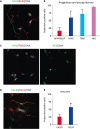1. Monuki ES, Walsh CA. Mechanisms of cerebral cortical patterning in mice and humans. Nat Neurosci. 2001; 4:Suppl. 1199–1206.

3. Masjosthusmann S, Becker D, Petzuch B, Klose J, Siebert C, Deenen R, Barenys M, Baumann J, Dach K, Tigges J, Hübenthal U, Köhrer K, Fritsche E. A transcriptome comparison of time-matched developing human, mouse and rat neural progenitor cells reveals human uniqueness. Toxicol Appl Pharmacol. 2018; 354:40–55.


5. Aubry MC, Aubry JP, Dommergues M. Sonographic prenatal diagnosis of central nervous system abnormalities. Childs Nerv Syst. 2003; 19:391–402.


6. Edwards L, Hui L. First and second trimester screening for fetal structural anomalies. Semin Fetal Neonatal Med. 2018; 23:102–111.


7. Gondré-Lewis MC, Gboluaje T, Reid SN, Lin S, Wang P, Green W, Diogo R, Fidélia-Lambert MN, Herman MM. The human brain and face: mechanisms of cranial, neurological and facial development revealed through malformations of holoprosencephaly, cyclopia and aberrations in chromosome 18. J Anat. 2015; 227:255–267.



8. Nagaraj UD, Lawrence A, Vezina LG, Bulas DI, duPlessis AJ. Prenatal evaluation of atelencephaly. Pediatr Radiol. 2016; 46:145–147.


9. Chen W, Xia X, Song N, Wang Y, Zhu H, Deng W, Kong Q, Pan X, Qin C. Cross-species analysis of gene expression and function in prefrontal cortex, hippocampus and striatum. PLoS One. 2016; 11:e0164295.

10. DeFelipe J, Alonso-Nanclares L, Arellano JI. Microstructure of the neocortex: comparative aspects. J Neurocytol. 2002; 31:299–316.

11. Molnár Z, Clowry G. Cerebral cortical development in rodents and primates. Prog Brain Res. 2012; 195:45–70.


12. Matsushita T, Fujihara A, Royall L, Kagiwada S, Kosaka M, Araki M. Immediate differentiation of neuronal cells from stem/progenitor-like cells in the avian iris tissues. Exp Eye Res. 2014; 123:16–26.


13. Pozzi D, Ban J, Iseppon F, Torre V. An improved method for growing neurons: Comparison with standard protocols. J Neurosci Methods. 2017; 280:1–10.


14. Sensenbrenner M, Deloulme JC, Gensburger C. Proliferation of neuronal precursor cells from the central nervous system in culture. Rev Neurosci. 1994; 5:43–53.


15. Xu SY, Wu YM, Ji Z, Gao XY, Pan SY. A modified technique for culturing primary fetal rat cortical neurons. J Biomed Biotechnol. 2012; 2012:803930.

16. Mota B, Herculano-Houzel S. Response to comments on “cortical folding scales universally with surface area and thickness, not number of neurons”. Science. 2016; 351:826.

17. Sauleau P, Lapouble E, Val-Laillet D, Malbert CH. The pig model in brain imaging and neurosurgery. Animal. 2009; 3:1138–1151.


18. Winterdahl M, Audrain H, Landau AM, Smith DF, Bonaventure P, Shoblock JR, Carruthers N, Swanson D, Bender D. PET brain imaging of neuropeptide Y2 receptors using N-11C-methyl-JNJ-31020028 in pigs. J Nucl Med. 2014; 55:635–639.


20. Bjarkam CR, Glud AN, Orlowski D, Sørensen JC, Palomero-Gallagher N. The telencephalon of the Göttingen minipig, cytoarchitecture and cortical surface anatomy. Brain Struct Funct. 2017; 222:2093–2114.


21. Radlowski EC, Conrad MS, Lezmi S, Dilger RN, Sutton B, Larsen R, Johnson RW. A neonatal piglet model for investigating brain and cognitive development in small for gestational age human infants. PLoS One. 2014; 9:e91951.

22. Rubio A, Belles M, Belenguer G, Vidueira S, Fariñas I, Nacher J. Characterization and isolation of immature neurons of the adult mouse piriform cortex. Dev Neurobiol. 2016; 76:748–763.


23. Markó K, Kohidi T, Hádinger N, Jelitai M, Mezo G, Madarász E. Isolation of radial glia-like neural stem cells from fetal and adult mouse forebrain via selective adhesion to a novel adhesive peptide-conjugate. PLoS One. 2011; 6:e28538.

24. Lu J, Delli-Bovi LC, Hecht J, Folkerth R, Sheen VL. Generation of neural stem cells from discarded human fetal cortical tissue. J Vis Exp. 2011; (51):2681.

25. Reddy RC, Amodei R, Estill CT, Stormshak F, Meaker M, Roselli CE. Effect of testosterone on neuronal morphology and neuritic growth of fetal lamb hypothalamus-preoptic area and cerebral cortex in primary culture. PLoS One. 2015; 10:e0129521.

26. Fu W, Ruangkittisakul A, MacTavish D, Baker GB, Ballanyi K, Jhamandas JH. Activity and metabolism-related Ca2+ and mitochondrial dynamics in co-cultured human fetal cortical neurons and astrocytes. Neuroscience. 2013; 250:520–535.


27. Hashimoto A, Onodera T, Ikeda H, Kitani H. Isolation and characterisation of fetal bovine brain cells in primary culture. Res Vet Sci. 2000; 69:39–46.


28. Yang H, Xia Y, Lu SQ, Soong TW, Feng ZW. Basic fibroblast growth factor-induced neuronal differentiation of mouse bone marrow stromal cells requires FGFR-1, MAPK/ERK, and transcription factor AP-1. J Biol Chem. 2008; 283:5287–5295.


31. Barnea A, Roberts J. An improved method for dissociation and aggregate culture of human fetal brain cells in serum-free medium. Brain Res Brain Res Protoc. 1999; 4:156–164.


32. Yu L, Vásquez-Vivar J, Jiang R, Luo K, Derrick M, Tan S. Developmental susceptibility of neurons to transient tetrahydrobiopterin insufficiency and antenatal hypoxia-ischemia in fetal rabbits. Free Radic Biol Med. 2014; 67:426–436.










 PDF
PDF Citation
Citation Print
Print



 XML Download
XML Download